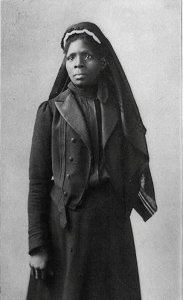Please meet the remarkable Susie King Taylor:
View attachment 118120
Susie King Taylor was born a slave at a plantation in
Liberty County,
Georgia, on August 6, 1848, as Susan Ann Baker. When she was about seven years old, her owner allowed her to go to
Savannah to live with her grandmother, Dolly. Taylor's admiration for women may have stemmed from her close relationship with Dolly. Despite Georgia's harsh laws against the formal education of African Americans, Dolly, with whom Taylor lived for much of her childhood, supported Taylor's education by sending her to an illegal school run by a free African-American woman, Mrs. Woodhouse. After learning all she could from Mrs. Woodhouse, Taylor continued her education under the tutelage of various "teachers", both white and black, including playmates, and the son of her grandmother's landlord. From them she gained the rudiments of
literacy, then extended her education with the help of two white youths, both of whom knowingly violated law and custom. Her education ended when she was forced to return to her mother on the Isle of Wight after Dolly was arrested at a suburban church meeting for singing freedom hymns. Taylor had to move back with her mother in Fort Pulaski but the Union took the fort not long after. Taylor fled with her uncle and his family to
St. Catherines Island, where they received Union protection and a transfer to
St. Simons Island. Taylor impressed the commanding officers with her ability to read and write and was offered a position running a school for children and adults on the island.
In April 1862, Susie Baker and many other African Americans fled to St. Simons Island, occupied at the time by Union forces. Within days her educational advantages came to the attention of army officers, who offered to obtain books for her if she would organize a school. She thereby became the first black teacher for freed African-American students to work in a freely operating freedmen's school in Georgia. She taught 40 children in day school and "a number of adults who came to me nights, all of them so eager to learn to read, to read above anything else." She taught there until October 1862, when the island was evacuated.
While at the school on St. Simons Island, Baker married Edward King, a black
noncommissioned officer in the First South Carolina Volunteers of African Descent (later reflagged as 33rd United States Colored Troops February 8, 1864, which was disbanded at
Fort Wagner in 1866). For three years she moved with her husband's and brothers' regiment, serving as nurse and
laundress, and teaching many of the black soldiers to read and write during their off-duty hours. In 1866 she and Edward returned to Savannah, where she established a school for the freed children. Edward King died in September 1866, a few months before the birth of their first child.
[3] There are few details about his death but scholars have noted that he died in a work-related accident at the pier unloading ships. Also around this time Taylor was forced to close her school when a free school opened nearby.
[4] In 1867 she returned to her native Liberty County to establish another school. In 1868 she slapped a white man then again relocated to Savannah, where she continued teaching
freedmen for another year and supported herself through small tuition charges, never receiving aid from the northern
freedmen's aid organizations. Historians say she,Taylor enrolled as a laundress at a camp named "Camp Saxton," The first suits the people wore were red coats and pants.
[5]
In the 1870s King traveled to
Boston as a
domestic servant of a wealthy white family. While there she met Russell L. Taylor, also a native of
Georgia. She returned home to
Liberty County to marry Taylor on April 20, 1879.
[6] She remained in
Boston for the rest of her life, returning to the South only occasionally. Taylor still kept in contact with her fellow veterans' group, the Grand Army of the Republic.
[7] After a trip to Louisiana in the 1890s to care for a dying son, she wrote her
Reminiscences, which were privately published in 1902. She died 10 years later. She is buried next to her second husband at
Mount Hope Cemetery in
Roslindale,
Massachusetts.




